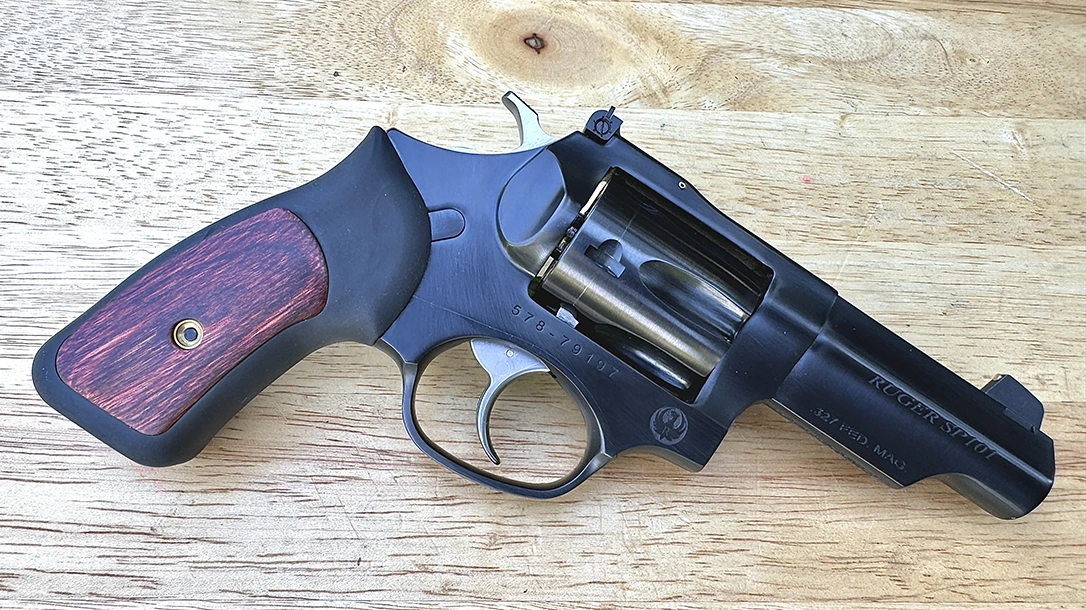I’m usually hesitant about jumping on the bandwagon for new cartridges. However, I must admit that I became a fan of the Federal .327 Magnum from the get-go. Introduced in 2008, it was an improvement on the 1984-era .32 H&R Magnum. So, when a company like Lipsey’s offers an option like the Ruger SP101 chambered in .327 Federal Magnum, I’m in.
Lipsey’s New Ruger SP101 in .327 Magnum
In 2020, Lipsey’s introduced a new Ruger SP101 in .357 Magnum. What was different about this wheelgun was it had a 3-inch, half-lug barrel, blue finish, and adjustable sights.
I did a T&E on one. But I told Jason Cloessner, Sr. VP and Product Development Mgr. at Lipsey’s, that what I really wanted to see would be a version just like it, in .327 Magnum. This would allow a 6-shot cylinder instead of just 5-shots like the .357 Magnum.
Advertisement — Continue Reading Below
What I got out of Jacob was, “Be patient, wait and see.”
I pestered Jacob about this idea every time I’d see him at the SHOT Show or other gun-writer gatherings. When I see him, I ask him, “Where’s the SP101 in .327 Magnum?”
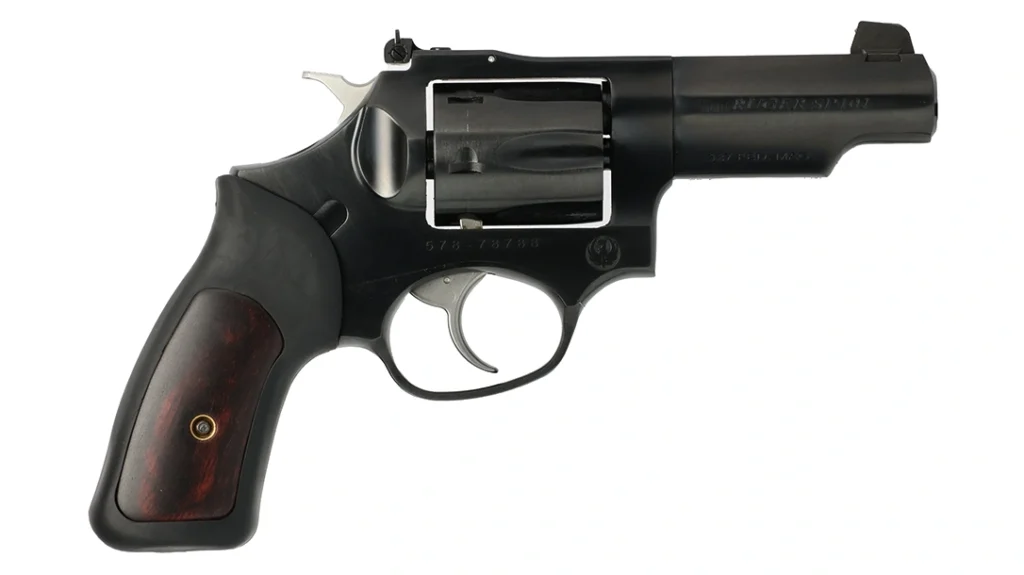
Advertisement — Continue Reading Below
Well, on August 8, I got an email from Jason entitled “Finally.”
My dream had come true, and Lipsey’s now was offering a Ruger SP101, as I mentioned, but with a 6-shot .327 Federal Magnum chambering!
The SP101 Arrives
When the box from Lipsey’s arrived, inside was a black plastic case. It had a big red RUGER logo and red closures. In addition, it has a foam-rubber-lined lid, a form-fitted lower, an owner’s manual, and a security padlock.
Advertisement — Continue Reading Below
The SP101 was nearly identical to the .357 Magnum model I’d tested four years ago. It has a 3-inch, half-lug barrel with a crowned muzzle that also is radiused. The top of the barrel is flat, and the dovetail mount contains a patridge-style front sight with a gold bead.
Its six-shot cylinder is fluted, and the extractor star is stainless steel. Cylinder locking points are on the breech-face and crane/yoke. On the left side of the frame, and incorporated into the recoil shield, is the press-in cylinder release latch.
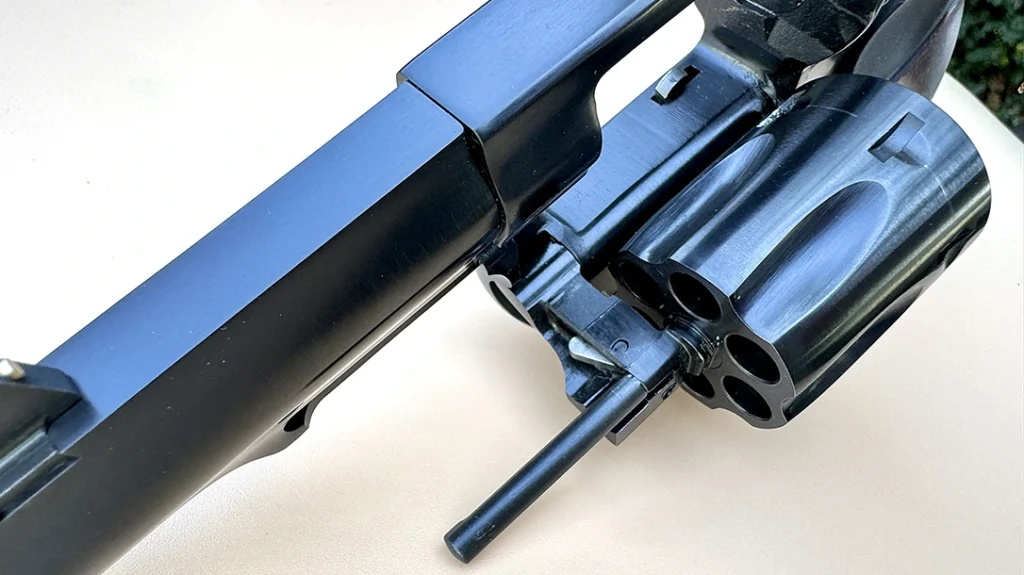
Advertisement — Continue Reading Below
The fully adjustable, square-notch rear sight is attached to the frame top strap with a roll-pin. It has a small but sturdy frame, which accounts for its 27 oz. empty weight.
This traditional double-action revolver has a transfer bar for safety and a frame-mounted firing pin. There’s an exposed hammer, and the trigger and action parts are stainless steel. Correspondingly, the hammer spur is checkered, and the 0.25-inch-wide trigger has a smooth face.
The single action trigger pull on my test gun was 5 lbs. 4 oz. Likewise, the DA pull was over the 12 Lbs. on my gauge; I’d have to guess it’s about 13-14 pounds. It should improve with use.
Advertisement — Continue Reading Below
The SP101 In Hand
Unlike most DA revolvers, the SP101 doesn’t have a conventional grip frame. It has a post/stud which houses the hammer mainspring. The revolver’s one-piece black rubber grip slips on over this post and is held in place by a grip screw and locator.
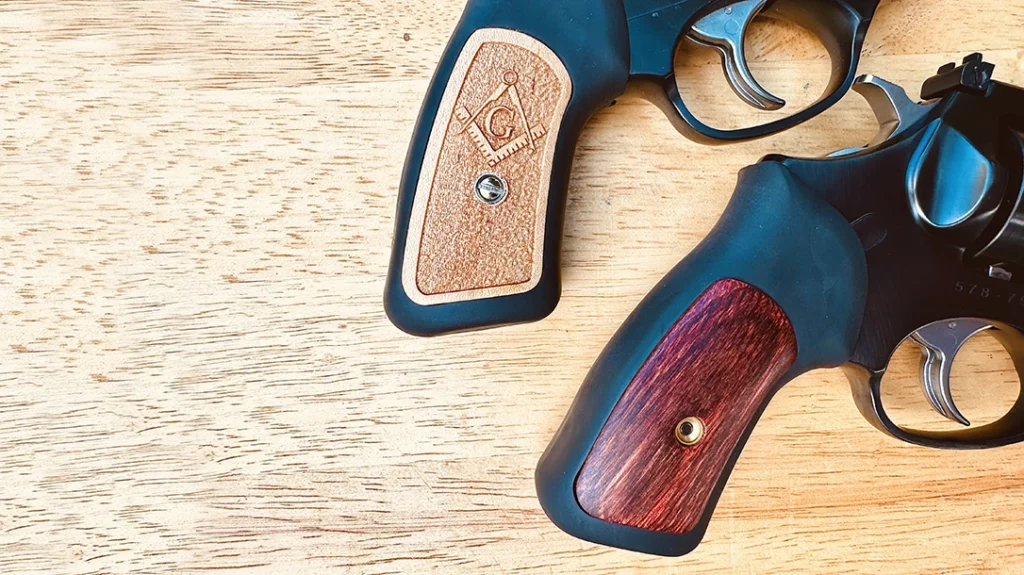
On the sides of the grip are laminated wood panels that dress things up a bit. The satin blue finish is even and attractive but not highly polished. The metal-to-metal fit is good, and no blemishes or machine marks were visible on the exterior. I also appreciate the minimal markings and stamping on the frame and barrel.
Advertisement — Continue Reading Below
.327 Federal Magnum
Improving on the .32 H&R Magnum, the new cartridge had a longer 1.20-inch case. It has a strengthened web at the base and thicker case walls to withstand pressure levels in the 45,000-psi range.
It can propel a .312-inch 100 gr. bullet at about 1,400 FPS, and offers .357 Magnum performance with less recoil. In addition, it also allows chambering six rounds in revolvers that only have a five-round capacity in .357 Magnum.
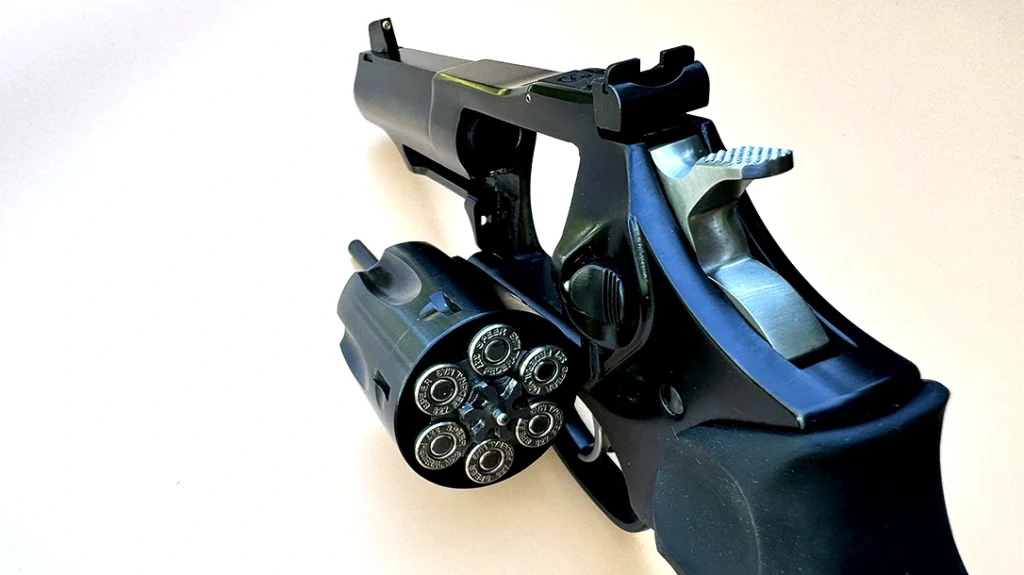
Advertisement — Continue Reading Below
Early on, Federal partnered with Ruger to produce a six-shot SP101 in .327 Magnum. Other manufacturers like Charter Arms and Taurus followed suit, but the new cartridge started out hot, then rapidly cooled. Now, sixteen years later, the .327 Federal Magnum and the .32 H&R Magnum fire appears to be rekindling.
Feeding the SP101
As the caliber stamping on the SP101 reads .327 Fed. Mag. I intended to mainly use this load in my T&E. The .327 Magnum’s claim to fame is .357 Magnum performance, with less recoil and muzzle flip.
A load I used on another .327 Mag. revolver test a few years back was DoubleTap’s DT Tactical. It has a Barnes 75 gr. all-copper HP bullet, with a velocity of “1,725 FPS from a 6” BBL,” per the box label.
Advertisement — Continue Reading Below
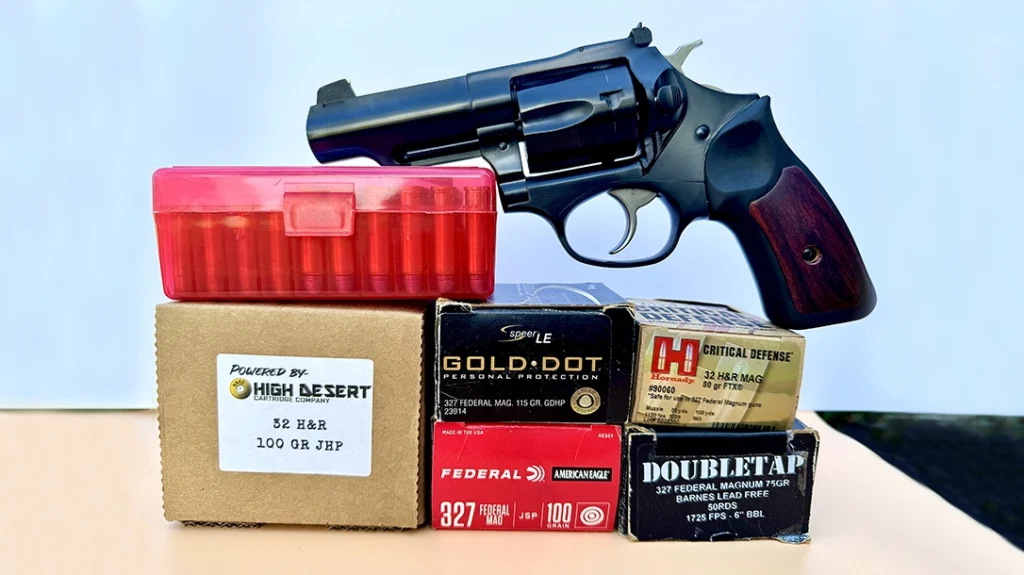
Federal provided its American Eagle .327 Magnum load that has a 100 gr. JSP bullet. I also selected Speer’s Gold Dot .327 Magnum load with a 115 gr. GD-HP bullet. I decided to try a .327 Magnum handload as well. It consisted of a 114 gr. lead HP bullet, driven by 4.7 gr. of Unique, with a standard small pistol primer.
In .32 H&R Magnum, I picked a 100 gr. JHP load from High Desert Cartridge Co. and Hornady’s Critical Defense, with an 80 gr. FTX-HP bullet.
Picking the Right Holster
For me, a blue steel revolver deserves good leather. So, the holster I chose was the Direct Line Carry Confidence CCR from Barranti Leather.
My holster is an open-top, high-ride, with a tension screw for security. The 1.5-inch belt loop is designed to prevent belt sag and holster rollout. It has a forward “FBI” tilt and mine came in Saddle Tan color.
I also used the Barranti Spare speedloader pouch. It has an open-top design, and the belt slot arrangement tucks the speedloader into the body for better concealment. My pouch had a brown finish, and I paired it with an HKS 32-J speedloader.
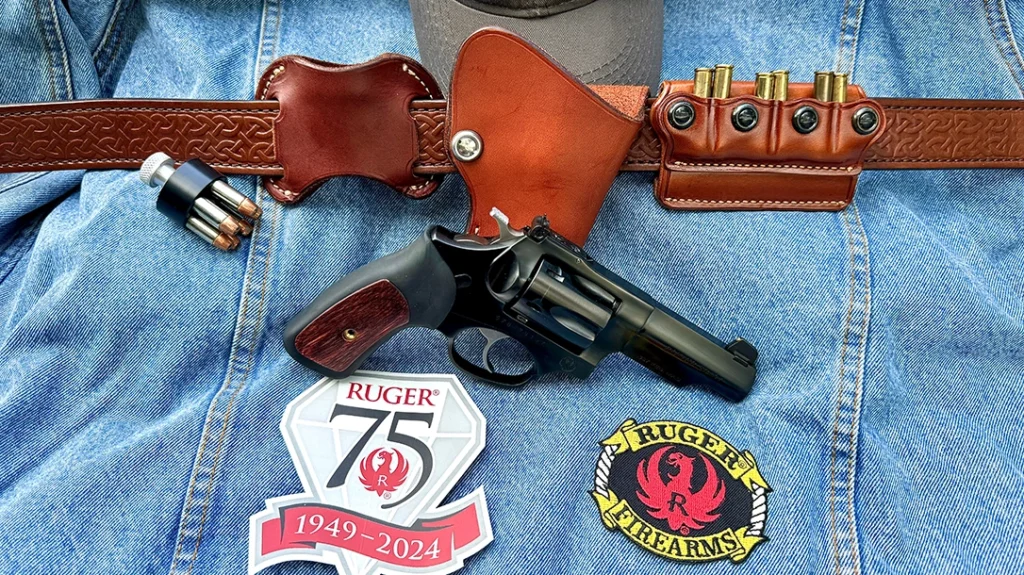
For six additional cartridges on my belt, I used Galco’s new Pick Six Ammo Carrier. This leather belt slide divides the cartridges into pairs, secured by tension screws, for easy speed or tactical reloading. Constructed of steerhide, it accommodates belts up to 1.75 inches in width. You can get it in a black or tan finish.
For a gun belt, I used a Bigfoot from Alien Gear. It is 1.5-inches wide and almost 0.25-inch thick to support almost any holstered handgun. All leather; mine is brown with Celtic Knot stamping and a nickel-plated brass buckle.
Range Time
My usual practice has been to do my accuracy testing at an indoor range. My first job was to sight-in the Lipsey’s/Ruger SP101 as the rear sight was lowered as far as it would go, and the sight notch blade was all the way to the right. Note: you will need two flat-head screwdrivers for this job; the windage adjustment screw is tiny.
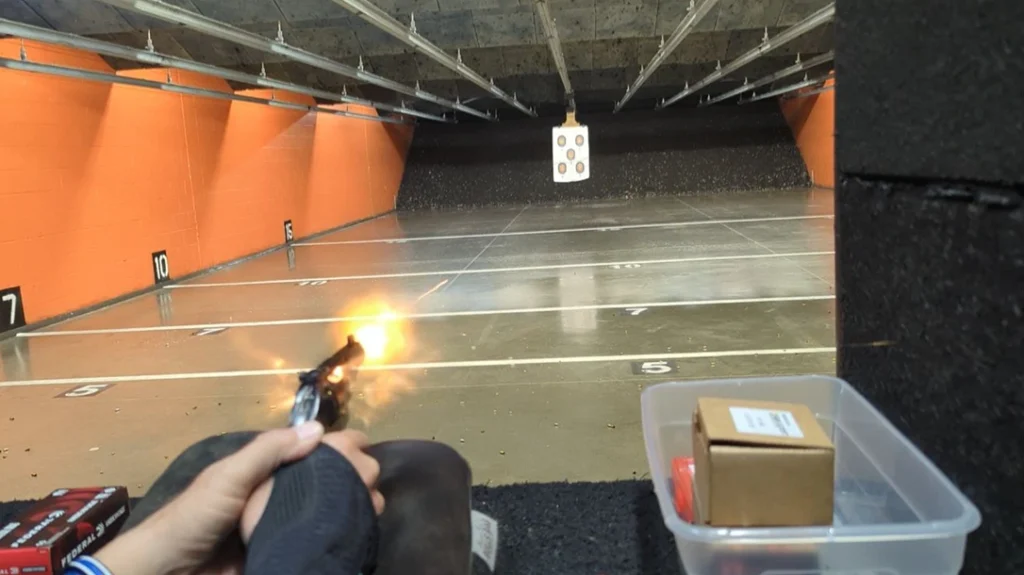
With the sixgun now sighted-in, I shot three 5-shot groups with each of the test loads. This was done at 15 yards from the bench, using a sandbag rest, in the SA mode. My best group measured 1.14 inches and was made using the Speer Gold Dot .327 Magnum load. It also had the best 3-group average of 1.09 inches. You can see all the group data in the performance table (below).
Next, I went outdoors to do my chronographing, some practical shooting, and bullet expansion testing. Out of the 3-inch barrel of the SP101, the .327 Magnum loads gave some impressive numbers. You can see that data in the below performance table, too.
I was curious how shooting a 30-round combat/qualification course would turn out using .327 Magnum ammo vs. .32 H&R Magnum loads. The silhouette target I was using had scoring rings that made a possible score of 305 points. A center shot in the Optical Triangle of the head was worth 15 points. Anything outside the 6-ring counted as a zero.
Combat/Qualification Course
With my leather gear on my belt, speedloader and cartridge slide loaded, plus the SP101 loaded and holstered, I prepared to engage the target using the High Desert 100 gr. JHP .32 H&R Magnum loads.
Shooting was at three, seven, and fifteen yards. It included strong and support-hand-only shooting, double taps, a failure drill, and barricade shooting. All stages started from the holster, with six rounds per stage for five stages.
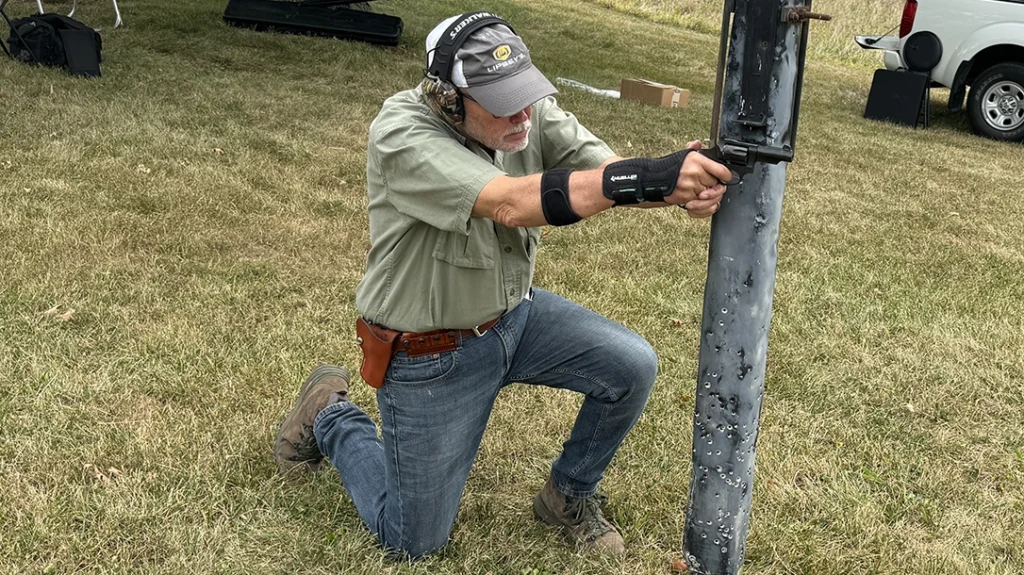
My score with the mild-shooting .32 Magnum loads came to 241/305. Not the best score, for sure. With little recoil or muzzle flip, I think my shooting with this load was faster. Also, the 12 rounds at 3 yards were scattered as I was shooting one-handed, with the stiff DA pull of the test gun.
I shot the same course using the Federal American Eagle 100 gr. JSP .327 Magnum loads. Recoil with this load isn’t bad. However, there is more muzzle flip and more concussion when shooting.
I guess as I doubled down on my hold of the SP101 with this round, I actually shot a bit better. Likewise, I also shot more deliberately and ended up with a score of 251/305. I did have one hit outside of the scoring rings—that was shot #2, left-hand only at 3 yards.
This .327 Magnum load has a pressure range of around 45,000 psi—some 10,000 psi more than a .357 Magnum. I had case sticking, flat primers, and cylinder lock-up. This only occurred with this cartridge.
I informed Jason at Lipsey’s about this situation, and we concurred that this was an ammo-related problem. A good thing to learn at the range.
Running Snakeshot
Doubletap makes an interesting cartridge in .32 H&R Magnum called the DT Snakeshot (it comes in .327 Magnum too). Inside the cartridge case are 100 pellets of #9 shot atop a 40 gr. lead wadcutter bullet. This payload is held in place with a copper gas check crimped at the mouth of the case.
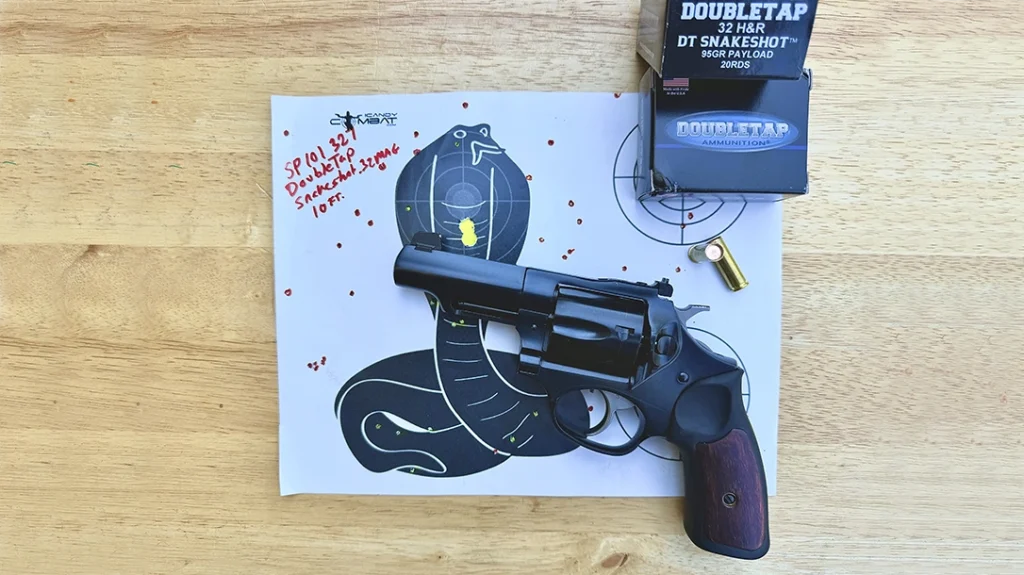
I took a shot at a snake target at 10 feet, using the SP101. The bullet and gas check hit one over the other, just below the snake’s head, and a number of pellets also hit Mr. No-shoulders.
I believe this round would solve the problem if you were within striking distance and couldn’t avoid a poisonous reptile.
Bullet Expansion/Penetration Test
My last exercise was a bullet expansion/penetration test. For this, I used a block of 10% ballistic gel from Clear Ballistics. On one end of the block, I affixed four layers of denim cloth as used in the FBI bullet testing protocol. I had five cartridges with JHP bullets and one with a JSP bullet.
I took one shot with each at the gel block from about 6 feet. The block was 16 inches long, and all but two of the bullets completely penetrated the block and were not recovered.
Most impressive was the DT Tactical load. It knocked the block right off the small folding table that I had it on. The monolithic copper HP bullet penetrated to 13.5 inches and mushroomed perfectly.
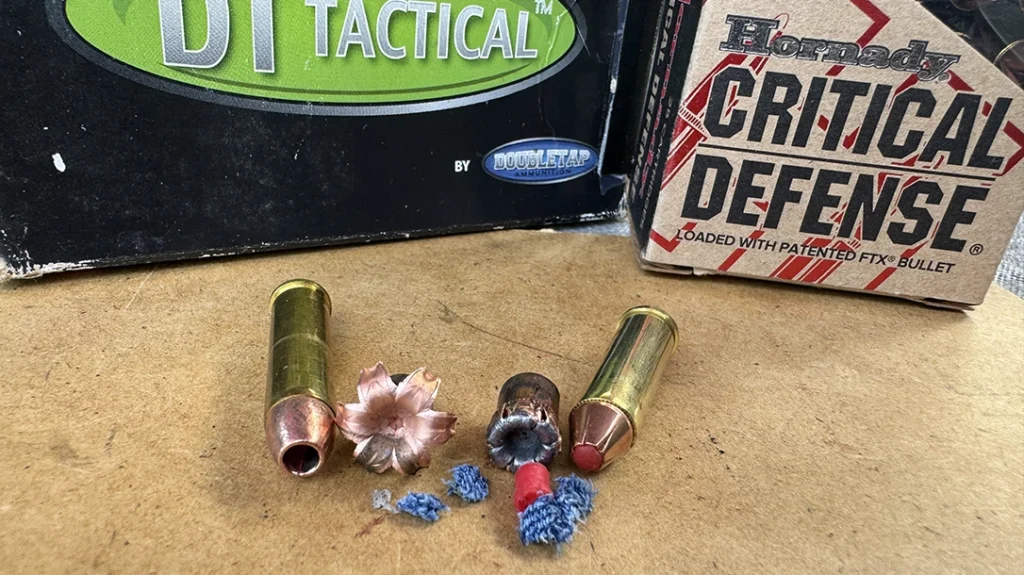
Another bullet that stopped in the block was the Hornady Critical Defense 80 gr. FTX-HP. Its red synthetic plug inside the hollow bullet nose kept the denim material out and allowed the bullet to expand.
When I cut it out of the block, it had apparently tumbled and was situated base forward, with the red plug just ahead of the bullet. Small bits of denim were found with both bullets.
Wrapping Up
Lipsey’s Ruger SP101 in .327 Magnum is a well-proportioned little revolver with a grip that fits my hand perfectly. I really like the 3-inch half-lug barrel and the gold bead front sight. I believe it has great potential as a self-defense weapon and a handy revolver for field use. It gave me no issues with the .32 H&R Magnum ammo or my handload.
I had two cylinder chambers that wanted to stick with the .327 Magnum factory loads. So, I decided to discontinue the use of the Federal .327 Magnum cartridges—especially for defensive use.
I lean heavily toward the Doubletap DT Tactical load for EDC. In my opinion, the .32 H&R Magnum cartridges just don’t have the “Umph” I want for defense. I plan to send this revolver back to Ruger to make sure any mechanical issues are resolved before I make serious use of it.
On a fun note, a company called LS Grips makes some nifty replacement grip inserts for the Ruger SP101. I ordered a special pair for my gun. I’m impressed enough that Lipsey’s won’t be getting it back after Ruger has checked it out.
For more information, please visit Lipseys.com, Ruger.com, BarrantiLeather.com, GalcoGunLeather.com, ClearBallistics.com, LSGrips.com, and AlienGearHolsters.com.
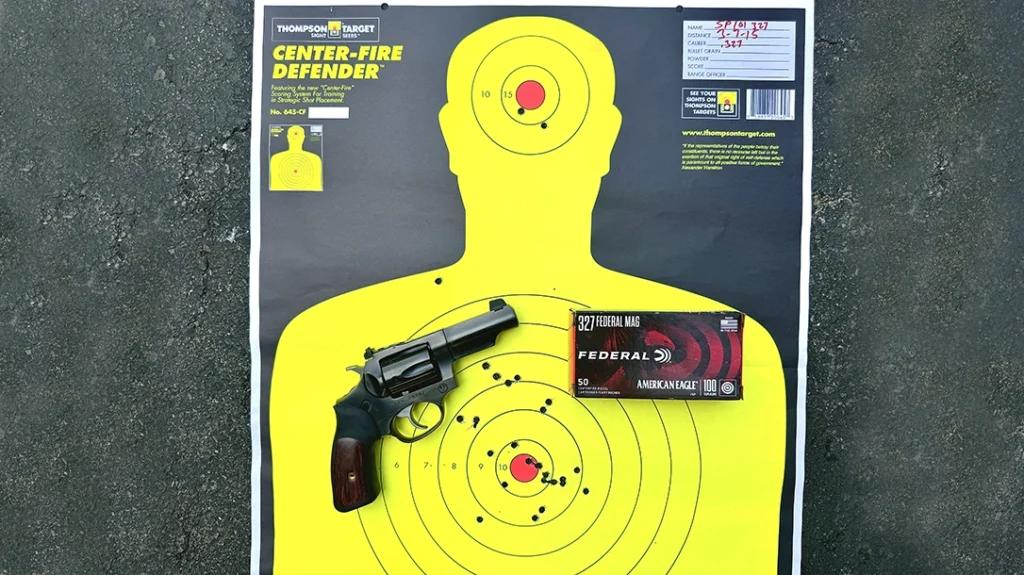
Lipsey’s Ruger SP101 Specs
| Mechanism | Traditional double-action revolver |
| Caliber | .327 Federal Magnum |
| Capacity | 6 cartridges |
| Barrel | 3.0 in. |
| Overall Length | 7.75 in. |
| Empty Weight | 27 oz. |
| Sights | Fully adjustable rear sight, gold bead front sight |
| Finish | Satin blue |
| Stocks | Black rubber with wood inserts |
| MSRP | $919.00 |
Performance
| Doubletap DT Tactical .327 Fed. 75 gr. Barnes All-Copper HP | |
| Average Velocity | 1,526 FPS |
| Best Group | 1.37 inches |
| Average Group | 2.38 inches |
| Ft-Pounds Muzzle Energy | 388 FPE |
| Federal American Eagle .327 Fed. 100 gr. JSP | |
| Average Velocity | 1,353 FPS |
| Best Group | 2.07 inches |
| Average Group | 2.44 inches |
| Ft-Pounds Muzzle Energy | 406 FPE |
| Speer Gold Dot LE Personal Protection .327 Fed. 115 gr. GD-HP | |
| Average Velocity | 1,338 FPS |
| Best Group | 1.14 inches |
| Average Group | 1.94 inches |
| Ft-Pounds Muzzle Energy | 457 FPE |
| .327 Mag. Handload 114 gr. Lead-HP, 4.7 gr. Unique | |
| Average Velocity | 994 FPS |
| Best Group | 2.04 inches |
| Average Group | 2.15 inches |
| Ft-Pounds Muzzle Energy | 250 FPE |
| High Desert .32 H&R 100 gr. JHP | |
| Average Velocity | 943 FPS |
| Best Group | 2.36 inches |
| Average Group | 2.55 inches |
| Ft-Pounds Muzzle Energy | 197 FPE |
| Hornady Critical Defense 80 gr. FTX-HP | |
| Average Velocity | 922 FPS |
| Best Group | 2.02 inches |
| Average Group | 2.33 inches |
| Ft-Pounds Muzzle Energy | 151 FPE |
NOTE: Bullet weight measured in grains, velocity in feet per second 10 ft. from the muzzle by an Oehler Model 35P chronograph, and accuracy in inches for three 5-shot groups at 15 yards. FPE based on bullet weight and velocity.
